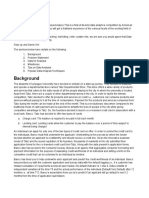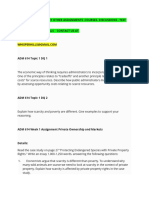Assignment 2-2
Uploaded by
Ushanthini NithanthanAssignment 2-2
Uploaded by
Ushanthini NithanthanNIAGARA UNIVERSITY
HOLZSCHUH COLLEGE OF BUSINESS ADMINISTRATION, MBA Program.
EC0 640 – ECONOMETRICS
Assignment 2
This assignment contains a section for each of the six steps in applied regression analysis. Your project is
to estimate an aggregate consumption function for the U.S. economy for the period 1945-2014.
Step 1: Review the Literature and Develop the Theoretical Model
John Maynard Keynes, one of the most influential economists since Adam Smith, developed the notion of
a consumption function, which explains total consumption as a function of disposable personal income.
You probably learned about the Keynesian consumption function in your principles of macroeconomics
class. Other variables, including interest rates, affect aggregate consumption, too.
a) One key analytical concept in the consumption function is the marginal propensity to consume. If
you already know the definition of the marginal propensity to consume, write down the
definition. If you don’t know the definition, read through your macroeconomic textbook, or find
an appropriate website and write down the definition, being sure to specify your source with a full
bibliographical reference.
b) Use the Google scholar database or another source to find two articles from academic journals
(not newspapers, blogs, or magazines) about the consumption function. You don’t need to read
the articles, but you must give the full bibliographic references for both articles in your report.
Step 2: Specify the Model: Select the Independent Variables and the Functional
At this point, you would normally choose your independent variables and your functional form. Since I’d
like everyone to estimate the same equation, I’ll make those decisions for you. Please estimate a linear
consumption function that includes disposable personal income and interest rates as your independent
variables. The specific variables will be:
Variable Description
yeart year t
CONt real personal consumption expenditures in year t, in billions of 2009 dollars
PYDt real disposable personal income in year t, in billions of 2009 dollars
AAAt the real interest rate on Aaa corporate bonds in year t
Write out your equation for consumption as a function of disposable personal income and the interest rate,
using the form of Equation 3.1 (from the textbook) but substituting the appropriate variable names for Y
and X.
Step 3: Hypothesize the Expected Signs of the Coefficients
Hypothesize the expected signs of the slope coefficients of your model. Explain your reasoning—if you
don’t know, read about it. That’s what literature reviews are for!
Step 4: Collect the Data. Inspect and Clean the Data
A handy source of macroeconomic data is the Federal Reserve Economic Data (FRED) website:
h ps://research.stlouisfed.org/fred2//. It contains hundreds of thousands downloadable time series from
the U.S. and around the world. This assignment uses data from FRED. However, to safe you some time I
have compiled the data and uploaded the dataset in excel to Canvas. The dataset name is Assignment2.
Finally, clean and inspect the data. To do this, print out the summary statistics (mean, standard deviation,
minimum, maximum) for all three variables and look for unusual numbers. Do you see any maximum or
minimum values that are impossible (like negative consumption) or unreasonably high (like interest rates
over 100%)? If so, that’s a clear mistake in the data. If not, the dataset is good, and you may proceed.
Steps 5: Estimate and Evaluate the Equation
Estimate your equation using R and print out the results. Then evaluate your results by answering the
following questions:
a) Do the signs of the coefficients meet the expectations you developed in Step 3? If not, explain
what differences there are.
b) According to your results, what is the value of the marginal propensity to consume (rounded to
three decimal places)? By how much will consumption change if disposable personal income falls
by $1 billion (holding constant the corporate bond Aaa rate)?
c) According to your results, by how much will consumption change if the corporate bond Aaa
interest rate rises by three percentage points (holding constant disposable personal income)?
d) Based on your answers to parts a-c above, does your regression result seem reasonable, or do you
think that you’ve made an error of some sort?
Step 6: Document the Results
Write an equation similar to Equation 3.4 from the textbook to document your results.
You might also like
- Refutation of - Some Observations, - by Frithjof Schuon - Criticizing René Guénon - Pages 16 To The End.No ratings yetRefutation of - Some Observations, - by Frithjof Schuon - Criticizing René Guénon - Pages 16 To The End.42 pages
- Managerial Economics 8th Edition Samuelson Solutions Manual 2024 scribd download full chapters100% (6)Managerial Economics 8th Edition Samuelson Solutions Manual 2024 scribd download full chapters33 pages
- Solution Manual for Managerial Economics, 8th Edition, William F. Samuelson, Stephen G. Marks download100% (4)Solution Manual for Managerial Economics, 8th Edition, William F. Samuelson, Stephen G. Marks download60 pages
- Get Solution Manual for Managerial Economics, 8th Edition, William F. Samuelson, Stephen G. Marks Free All Chapters Available100% (6)Get Solution Manual for Managerial Economics, 8th Edition, William F. Samuelson, Stephen G. Marks Free All Chapters Available59 pages
- Full Download of Solution Manual for Managerial Economics and Organizational Architecture 5th Edition by Brickley in PDF DOCX Format100% (4)Full Download of Solution Manual for Managerial Economics and Organizational Architecture 5th Edition by Brickley in PDF DOCX Format57 pages
- Managerial Economics 8th Edition Samuelson Solutions Manualpdf download100% (1)Managerial Economics 8th Edition Samuelson Solutions Manualpdf download41 pages
- Solution Manual for Managerial Economics and Organizational Architecture 5th Edition by Brickley 2024 scribd download full chapters100% (6)Solution Manual for Managerial Economics and Organizational Architecture 5th Edition by Brickley 2024 scribd download full chapters61 pages
- Solution Manual for Managerial Economics, 8th Edition, William F. Samuelson, Stephen G. Marks - PDF Version Is Available For Instant Access100% (7)Solution Manual for Managerial Economics, 8th Edition, William F. Samuelson, Stephen G. Marks - PDF Version Is Available For Instant Access48 pages
- Example Metrics - Final Assignment - WS1920 - SHNo ratings yetExample Metrics - Final Assignment - WS1920 - SH9 pages
- Solution Manual for Managerial Economics and Organizational Architecture 5th Edition by Brickley - Quick Download In Full PDF Format With All Chapters100% (5)Solution Manual for Managerial Economics and Organizational Architecture 5th Edition by Brickley - Quick Download In Full PDF Format With All Chapters51 pages
- Managerial Economics 8th Edition Samuelson Solutions Manual - Available For Instant Download And Reading100% (3)Managerial Economics 8th Edition Samuelson Solutions Manual - Available For Instant Download And Reading46 pages
- 593Managerial Economics 8th Edition Samuelson Solutions Manual download100% (1)593Managerial Economics 8th Edition Samuelson Solutions Manual download57 pages
- Microeconomics Canadian 15th Edition Ragan Solutions Manual - Quickly Download For The Best Reading Experience100% (3)Microeconomics Canadian 15th Edition Ragan Solutions Manual - Quickly Download For The Best Reading Experience35 pages
- Solution Manual for Managerial Economics 8th Edition Samuelson Marks 1118808940 9781118808948 - All Chapters Are Available In PDF Format For Download100% (1)Solution Manual for Managerial Economics 8th Edition Samuelson Marks 1118808940 9781118808948 - All Chapters Are Available In PDF Format For Download48 pages
- Solution Manual for Managerial Economics, 8th Edition, William F. Samuelson, Stephen G. Markspdf download100% (2)Solution Manual for Managerial Economics, 8th Edition, William F. Samuelson, Stephen G. Markspdf download43 pages
- Enjoy an instant PDF download of the complete Solution Manual for Managerial Economics 8th Edition Samuelson Marks 1118808940 9781118808948.100% (8)Enjoy an instant PDF download of the complete Solution Manual for Managerial Economics 8th Edition Samuelson Marks 1118808940 9781118808948.46 pages
- To Order This and Any Other Assignments, Courses, Discussions, Test Bank and Solution Manuals Contact Us at0% (1)To Order This and Any Other Assignments, Courses, Discussions, Test Bank and Solution Manuals Contact Us at9 pages
- Solution Manual for Managerial Economics, 8th Edition, William F. Samuelson, Stephen G. Marks - Download Today With Full Content100% (4)Solution Manual for Managerial Economics, 8th Edition, William F. Samuelson, Stephen G. Marks - Download Today With Full Content42 pages
- Solution Manual for Managerial Economics and Organizational Architecture 5th Edition by Brickley pdf download100% (2)Solution Manual for Managerial Economics and Organizational Architecture 5th Edition by Brickley pdf download56 pages
- Instant download Microeconomics Canadian 15th Edition Ragan Solutions Manual pdf all chapter100% (4)Instant download Microeconomics Canadian 15th Edition Ragan Solutions Manual pdf all chapter49 pages
- Optimal Decisions Using Marginal Analysi PDFNo ratings yetOptimal Decisions Using Marginal Analysi PDF20 pages
- Regression: An Introduction To EconometricsNo ratings yetRegression: An Introduction To Econometrics19 pages
- Enjoy immediate access to the full Solution Manual for Managerial Economics and Organizational Architecture 5th Edition by Brickley in PDF.100% (4)Enjoy immediate access to the full Solution Manual for Managerial Economics and Organizational Architecture 5th Edition by Brickley in PDF.62 pages
- Download Study Resources for Solution Manual for Managerial Economics and Organizational Architecture 5th Edition by Brickley100% (10)Download Study Resources for Solution Manual for Managerial Economics and Organizational Architecture 5th Edition by Brickley58 pages
- Complete Download of Microeconomics Canadian 15th Edition Ragan Solutions Manual Full Chapters in PDF DOCX100% (2)Complete Download of Microeconomics Canadian 15th Edition Ragan Solutions Manual Full Chapters in PDF DOCX41 pages
- Assessment #2 2023A - Topic1 - Energy (Instructions)No ratings yetAssessment #2 2023A - Topic1 - Energy (Instructions)3 pages
- Finance a Step-By-Step Guide to Earnings Modelling and Stock Valuation for Investment Analysis (Benusa, Darlena) (Z-Library)No ratings yetFinance a Step-By-Step Guide to Earnings Modelling and Stock Valuation for Investment Analysis (Benusa, Darlena) (Z-Library)683 pages
- Practice Problems On Descriptive StatisticsNo ratings yetPractice Problems On Descriptive Statistics4 pages
- Macroeconomics Fourteenth Canadian Edition Canadian 14th Edition Ragan Solutions Manual - Download PDF100% (3)Macroeconomics Fourteenth Canadian Edition Canadian 14th Edition Ragan Solutions Manual - Download PDF38 pages
- Financial Plans for Successful Wealth Management In Retirement: An Easy Guide to Selecting Portfolio Withdrawal StrategiesFrom EverandFinancial Plans for Successful Wealth Management In Retirement: An Easy Guide to Selecting Portfolio Withdrawal StrategiesNo ratings yet
- Stability of Carotenoids and Vitamin A DuringNo ratings yetStability of Carotenoids and Vitamin A During7 pages
- Manual of Pesticide Residue Analysis Volume II PDFNo ratings yetManual of Pesticide Residue Analysis Volume II PDF493 pages
- Customer Perception Towards Chinese Mobile Brands in Indian Market With Special Reference To Cuddalore DistrictNo ratings yetCustomer Perception Towards Chinese Mobile Brands in Indian Market With Special Reference To Cuddalore District97 pages
- First-Order Logic in Artificial IntelligenceNo ratings yetFirst-Order Logic in Artificial Intelligence38 pages
- Petroleum Engineering Course ArrangementNo ratings yetPetroleum Engineering Course Arrangement1 page
- Customs and Traditions Listening While Watching100% (2)Customs and Traditions Listening While Watching4 pages
- Do You Agree or Disagree That A Sense of Competition Motivates Young PeopleNo ratings yetDo You Agree or Disagree That A Sense of Competition Motivates Young People1 page
- Affinity Laws For Variable Speed Centrifugal PumpsNo ratings yetAffinity Laws For Variable Speed Centrifugal Pumps4 pages

























































































